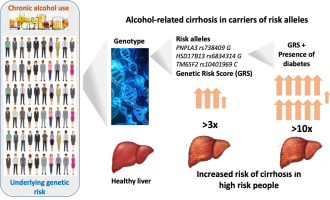News release
From:
An international research group led by the Centenary Institute has developed a world first genetic risk score (GRS) test able to identify patients at high-risk of developing alcohol-related cirrhosis.
Cirrhosis (scarring of the liver) is responsible for approximately 300,000 deaths each year world-wide.
In their study the researchers found that a high GRS from the test of excessive alcohol consumers meant a three-fold increase in cirrhosis risk. The presence of diabetes together with a high GRS increased the cirrhosis risk among drinkers more than 10-fold.
Clinical Associate Professor Devanshi Seth, Head of the Centenary Institute’s Alcoholic Liver Disease Research Program and joint senior author of the study, said that only a minority of high-risk drinkers – approximately 10-15 percent – actually end up developing alcohol-induced cirrhosis. To date, however, there had been no way to identify those at-risk individuals.
“Our GRS test lets us identify at-risk individuals at an early stage enabling the application of focused interventions. Evidence suggests that even just informing excessive drinkers that they have an increased cirrhosis risk may motivate them to reduce their alcohol intake, helping prevent serious disease,” said Clinical Associate Professor Seth.
Dr John Whitfield from QIMR Berghofer Medical Research Institute and lead author of the study said the test had been developed by examining samples from patients with and without alcohol-related cirrhosis, but all with a history of heavy alcohol consumption.
“This was classified as men consuming more than 80 grams (8 standard drinks) of alcohol daily and women more than 50 grams daily, both for a time period of ten or more years.”
“Risk scores were computed by the analysis of up to eight gene variations and three clinical risk factors (including type 2 diabetes) associated with alcohol-related cirrhosis,” Dr Whitfield said.
“We’ve shown that a GRS based on only three genetic risk variants plus diabetes status can be extremely meaningful in determining overall cirrhosis risk. Our test will allow for early and personalised management of high-risk patients,” said Clinical Associate Professor Seth, also a Principal Scientist at the Edith Collins Centre, Royal Prince Alfred Hospital, Sydney Local Health District.
The study, published in the Journal of Hepatology, was undertaken by the multi-national GenomALC Consortium with USA co-lead Dr Timothy R Morgan from the Southern California Institute of Research and Education; and funded by the National Institute on Alcohol Abuse and Alcoholism (NIAAA) a part of the National Institutes of Health (NIH), USA.
Publication:
A genetic risk score and diabetes predicts development of alcohol-related cirrhosis in drinkers. https://www.journal-of-hepatology.eu/article/S0168-8278(21)02111-5/
About the Centenary Institute
The Centenary Institute is a world-leading independent medical research institute, closely affiliated to the University of Sydney and the Royal Prince Alfred Hospital. Our research focuses on three key areas: cancer, inflammation and cardiovascular disease. Our strength lies in uncovering disease mechanisms and applying this knowledge to improve diagnostics and treatments for patients.
For more information about the Centenary Institute, visit centenary.org.au
About the GenomALC Consortium
The GenomALC Consortium is a collaboration between a number of research groups
worldwide who are contributing data collected on individuals with unhealthy alcohol use,
with the aim of gaining a better understanding of the genetic effects involved in the
development of liver diseases.
For more information about the GenomALC Consortium, visit genomalc.org/
Multimedia





 Australia; NSW
Australia; NSW



